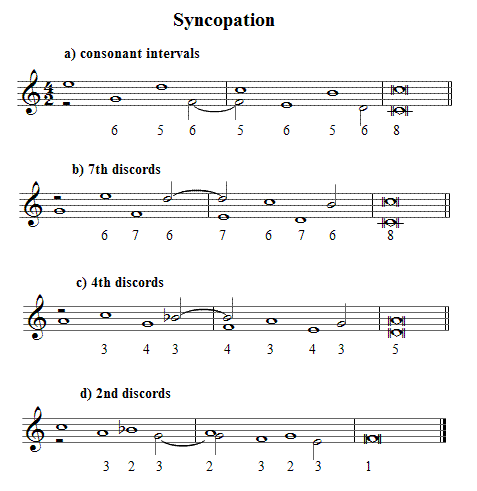APPENDIX A: VOICE LEADING OVERVIEW
Syncopation
If we take an example where one of the voices delays its movement so that its note is held across from a weak beat onto a stronger beat of the bar, we get a type of counterpoint called syncopation. This creates new possibilities in voice leading patterns. This is sometimes referred to as Fourth Species counterpoint.
In two part writing, syncopation produces several possible patterns as follows:

I've shown successions of syncopations in the above examples, mainly to show how they work in different positions in the bar but it is equally possible to have a single syncopation connected with other patterns. Fourth species patterns are common in cadence bars - see also example within the earlier section on Arpeggiation and Passing Notes.
In a) the syncopation results in the interval of a 5th alternating with the interval of the 6th. In this example of syncopation the intervals are all consonant.
However, in other examples the syncopation creates a new kind of discord called the suspension.
Here, the dissonance occurs on strong beats (first and third) rather than on weak beats as is normally the case with the passing note. (See Arpeggiation and Passing Notes) The discord is prepared by the presence of the same note tied from the previous beat and the discord is resolved by a stepwise movement downward onto a consonant note on the next beat.
In b) the syncopation creates the dissonant interval of the 7th on the strong first and third beats. The first example is major and remaining two examples are minor 7ths.
In c) the dissonance of the 4th is created on the strong beats.
In d) the dissonant interval of a 2nd is created on the strong beats. One is a minor 2nd and the other two are major 2nds.
Next Topic: Voice Leading Patterns Combined

